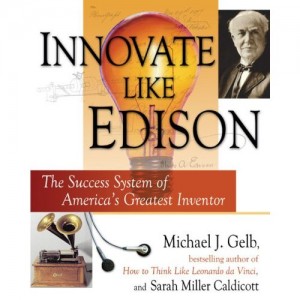Edison as Mashup Artist: Combining Discipline, Process and Intuition
 Innovate Like Edison is a must-read for anyone who wants to thrive in the “flat world.” Had it been written in the 20th century, the book would have been applicable to R&D leaders, and it would have been a nice-to-have for business and government leaders. Innovation was the place kicker on the team during the Industrial Economy because companies created value through efficiency (refining continuous processes), and innovation is about discontinuous processes.
Innovate Like Edison is a must-read for anyone who wants to thrive in the “flat world.” Had it been written in the 20th century, the book would have been applicable to R&D leaders, and it would have been a nice-to-have for business and government leaders. Innovation was the place kicker on the team during the Industrial Economy because companies created value through efficiency (refining continuous processes), and innovation is about discontinuous processes.
In the 21st century Knowledge Economy, however, innovation is the linebacker. Customers merely expect world-class efficiency, but it rarely differentiates. Innovation is now a core competency at most levels of every organization.
The problem is, the authors explain, is that very few people are innovation literate, and they don’t know how to practice it practically. As I’ve written extensively, business innovation failures are over 95%, and most new products fail at high rates. We must reposition innovation as a linebacker, and that means understanding it differently and treating it differently.
In the 21st century, innovation is a group effort, no longer a specialist activity. Therefore, this book is one of the key guidebooks of government and business leaders, and it’s also a fascinating read. Here’s why:
- The book simultaneously tells a fascinating story about Edison *and* uses it to illustrate Edison’s best practices as an innovator.
- It presents the “Edison Innovation Literacy Blueprint,” which you can use to start increasing innovation literacy, whether your context is commercial, volunteer work or government. It is well thought out and practical.
- It is a call to action for people in mature, rich economies. In the U.S., people are used to being the disruptors, the challengers. However, the U.S. is in full middle age, and it must reinvent itself if it wants to remain competitive.
For me, where the book breaks into exceptional territory is on the philosophical level. The book reveals that Edison, while a hard-nosed, practical person, also trusted his intuition and encouraged others to do the same. For example, he saw nature as perfect and that it was comprised of mathematical patterns, all we have to do is to recognize them. Think about that a minute. We find what we seek, and if we believe that patterns exist, we have a greater chance of finding them.
There is nothing flakey about intuition because it is a means to access a far greater part of our brains. We have to suspend judgement on things and hold them in our concentration (our internal “desktops”). This allows us to mash them up with other things that might reveal patterns. One of my favorites: pick two things that do not seemingly go together and explore how they might. Challenge prevailing assumptions, which are the highest barriers to innovating. Edison was a master of this, and the book includes several practical techniques to build your capability.
Another pearl refines the prevailing wisdom of “kill your losers fast.” Edison recognized that innovation, ideas or products were packages of patterns. If something didn’t appear to be working, he did not “kill” it. He was more mentally flexible because he recognized that the package was not working; there was undoubtedly much gold in some of the pieces, and the book gives several examples. Most corporations’ innovation vaults of full of failed innovations, which never again see the light of day.
The Knowledge Economy is transforming the world into a pervasive network of people, and knowledge will be free. In the Industrial Economy, physical power became essentially free. This means that people will add value by mashing things up, by finding patterns.
Innovate Like Edison is an excellent guidebook for nurturing your own internal mashup artist.

Leave a Reply
You must be logged in to post a comment.